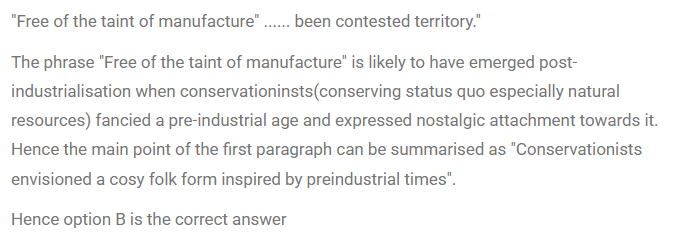CAT RC Questions | CAT RC- Social Science questions
FundaMakers is the Best CAT Online Coaching In India. Now prepare for CAT anytime with FundaMakers. We provide well-ordered syllabus coverage for both offline and online CAT preparation batches. FundaMakers brings to you the power-packed, well-structured CAT previous year question bank with more than 4000+ CAT Past Year questions. In the VARC section, one of the most frequently asked questions is from the topic- Reading Comprehension. Reading Comprehension turns out to be an important part of the VARC section from which over 60-70% of the questions are based on RC in the CAT Exam.
FundaMakers as a team has taken a painstaking step to bring you all the video solutions of the Reading Comprehension asked in the Previous Year CAT exam. CAT question bank offered by FundaMakers is a power-packed topic-wise compilation of the entire CAT previous year questions. Questions from the Reading Comprehension topic are some of the most scoring questions in the VARC section. To maximize your CAT score make use of FundaMakers CAT Question Bank. “Questions from CAT previous years” examination papers have been incorporated. Let’s get started with CAT Past Year Reading Comprehension Questions.
Comprehension
Directions for question: Read the passage carefully and answer the given questions accordingly
"Free of the taint of manufacture" – that phrase, in particular, is heavily loaded with the ideology of what the Victorian socialist William Morris called the "anti-scrape", or an anti- capitalist conservationism (not conservatism) that solaced itself with the vision of a pre- industrial golden age. In Britain, folk may often appear a cosy, fossilised form, but when you look more closely, the idea of folk – who has the right to sing it, dance it, invoke it, collect it, belong to it or appropriate it for political or cultural ends – has always been contested territory. . . .
In our own time, though, the word "folk" . . . has achieved the rare distinction of occupying fashionable and unfashionable status simultaneously. Just as the effusive floral prints of the radical William Morris now cover genteel sofas, so the revolutionary intentions of many folk historians and revivalists have led to music that is commonly regarded as parochial and conservative. And yet – as newspaper columns periodically rejoice – folk is hip again, influencing artists, clothing and furniture designers, celebrated at music festivals, awards ceremonies and on TV, reissued on countless record labels. Folk is a sonic "shabby chic", containing elements of the uncanny and eerie, as well as an antique veneer, a whiff of Britain's heathen dark ages. The very obscurity and anonymity of folk music's origins open up space for rampant imaginative fancies. . . .
[Cecil Sharp, who wrote about this subject, believed that] folk songs existed in constant transformation, a living example of an art form in a perpetual state of renewal. "One man sings a song, and then others sing it after him, changing what they do not like" is the most concise summary of his conclusions on its origins. He compared each rendition of a ballad to an acorn falling from an oak tree; every subsequent iteration sows the song anew. But there is tension in newness. In the late 1960s, purists were suspicious of folk songs recast in rock idioms. Electrification, however, comes in many forms. For the early-20th-century composers such as Vaughan Williams and Holst, there were thunderbolts of inspiration from oriental mysticism, angular modernism and the body blow of the first world war, as well as input from the rediscovered folk tradition itself.
For the second wave of folk revivalists, such as Ewan MacColl and AL Lloyd, starting in the 40s, the vital spark was communism's dream of a post-revolutionary New Jerusalem. For their younger successors in the 60s, who thronged the folk clubs set up by the old guard, the lyrical freedom of Dylan and the unchained melodies of psychedelia created the conditions for folk- rock's own golden age, a brief Indian summer that lasted from about 1969 to 1971. . . . Four decades on, even that progressive period has become just one more era ripe for fashionable emulation and pastiche. The idea of a folk tradition being exclusively confined to oral transmission has become a much looser, less severely guarded concept. Recorded music and television, for today's metropolitan generation, are where the equivalent of folk memories are seeded. . . .
CAT/2019.1
Question . 140
The author says that folk “may often appear a cosy, fossilised form” because:
Explanatory Answer
Method of solving this CAT RC Question from RC- Social Science question
Correct Option: B

Hey!
Worried about IIM calls due to your marks in 10th,12th, and Graduation?
Don't worry! Know your chances of getting an IIM Call based on your profile with our:-
Profile Professor: https://fundamakers.com/profile-professor/

5 Must- NOT-Dos during CAT Preparation.
- Do not treat CAT as 'Everything'.
- Do not quit your job for CAT exam preparation.
- Learning till The Eleventh hour instead of doing proper revision.
- Not checking the syllabus thoroughly.
- Piling up multiple books.
Click To Read:- Common mistakes made by CAT aspirants during preparation.
FundaMakers- Best Online and Offline CAT Online Preparation Institute in India
For any CAT Preparation related query, reach out to us at 9598333344.